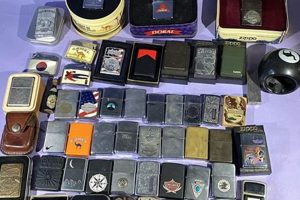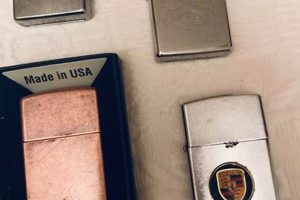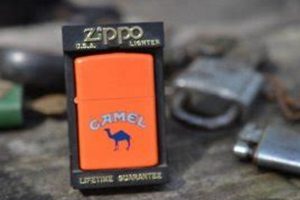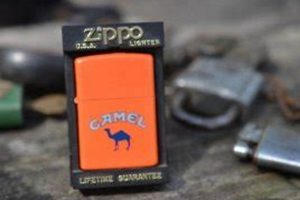From the first model introduced in the early 1930s to the diverse range of contemporary designs, these iconic windproof lighters represent a significant segment of lighter history. The evolution of their design, features, and commemorative releases provides a tangible illustration of changing aesthetics, manufacturing processes, and historical events spanning nearly a century. Examining this progression offers a unique lens through which to observe the interplay of industrial design, material culture, and social trends.
The enduring popularity of these pocket lighters stems from their robust construction, reliable functionality, and the distinctive “click” sound they produce. Their collectability is further enhanced by the sheer variety of finishes, engravings, and limited-edition releases, creating a rich and dynamic market for enthusiasts and historians alike. Studying these variations offers valuable insights into branding, commemorative practices, and the cultural impact of everyday objects. Moreover, the history of these lighters offers a case study in the evolution of a successful consumer product, demonstrating adaptation and innovation across decades.
This exploration will delve into key periods and notable models, examining the design modifications, materials used, and the cultural context surrounding their introduction. Furthermore, it will analyze the factors contributing to their sustained popularity and the development of a vibrant collector community. Finally, the influence of historical events and popular culture on specific designs will be considered.
Collecting and Caring for Vintage Lighters
Preserving the value and functionality of vintage lighters requires careful attention to several key factors.
Tip 1: Authentication is Crucial: Verify a lighter’s authenticity before acquiring it. Examine markings, construction, and materials for consistency with known production periods. Reference reputable resources like official company archives or established collector guides.
Tip 2: Proper Storage Matters: Store lighters in a cool, dry environment away from direct sunlight and extreme temperatures. Avoid storing them fueled for extended periods to prevent fuel evaporation and potential damage to seals.
Tip 3: Gentle Cleaning Recommended: Clean lighters using appropriate methods and materials. A soft cloth and specialized lighter fluid can remove surface grime and tarnish. Avoid abrasive cleaners or harsh chemicals.
Tip 4: Handle with Care: Avoid dropping or impacting lighters, as this can damage internal components or the exterior finish. Exercise caution when refilling or adjusting the flame height.
Tip 5: Understand Flint Replacement: Learn the correct procedure for replacing flints and wicks in your specific lighter model. Using incorrect replacements can lead to malfunctions.
Tip 6: Research Market Value: Consult price guides, auction records, and online forums to understand the current market value of specific models and variations. This knowledge is essential for both buying and selling.
By adhering to these guidelines, collectors can ensure the long-term preservation and enjoyment of these historical artifacts. Proper care maintains both the functional integrity and the historical value of each piece.
The insights provided within this guide offer practical advice for both seasoned collectors and those newly interested in exploring the world of vintage lighters. The following section will provide further resources and avenues for continued learning.
1. Design Evolution
Design evolution is integral to understanding the historical trajectory of Zippo lighters. Changes in form and function reflect not only advancements in manufacturing processes but also shifting aesthetic preferences and functional requirements. The earliest models, with their squared corners and flat bottoms, evolved through various iterations, leading to the rounded corners and contoured shapes recognized today. The introduction of the windproof chimney, a defining feature, underwent refinements to optimize performance in various conditions. Examining these design modifications provides insights into the company’s responsiveness to consumer needs and technological advancements.
For example, the transition from soldered to seamless bottom stamps reflects improvements in manufacturing efficiency and enhanced durability. The development of various hinge mechanisms, from the original three-barrel hinge to the five-barrel hinge, demonstrates a focus on improved longevity and reliability. Furthermore, the introduction of new insert designs, such as the butane insert, broadened the functionality and appeal of the product line. Analyzing these changes offers a tangible illustration of the interplay between engineering, design, and market demands.
Understanding the design evolution of Zippo lighters provides collectors and enthusiasts with a framework for identifying and appreciating specific models and their historical context. This knowledge is crucial for authentication, valuation, and appreciating the nuances of collecting. Moreover, studying the design evolution offers a valuable case study in product development and adaptation within a competitive consumer market, demonstrating the importance of innovation and responsiveness to changing consumer preferences and technological possibilities.
2. Manufacturing Processes
Manufacturing processes play a crucial role in the history and development of Zippo lighters. The evolution of these processes directly impacted the quality, durability, and design possibilities of the lighters produced throughout the decades. Early production relied on simpler machining and finishing techniques, evolving to incorporate more sophisticated methods like automated assembly and precision stamping. These advancements not only increased production efficiency but also contributed to the consistent quality and reliability associated with the brand. For example, the introduction of automated machinery allowed for the creation of more intricate designs and engravings, expanding the range of available styles and finishes.
The shift from brass to steel during World War II, driven by material shortages, exemplifies the adaptability of Zippo’s manufacturing processes in response to external factors. This change, while initially necessitated by wartime constraints, ultimately demonstrated the versatility of the lighter’s design and its ability to function reliably with different materials. Post-war, the return to brass and the subsequent introduction of new materials like chrome and sterling silver further highlight the ongoing evolution of manufacturing processes and their influence on the diversity of available models. Analyzing specific examples, such as the development of the company’s signature bottom stamp, provides further insight into the interplay between manufacturing techniques and the creation of distinctive design elements.
Understanding the evolution of Zippo’s manufacturing processes provides valuable context for assessing the quality and authenticity of different models. This knowledge allows collectors and enthusiasts to appreciate the technical advancements that contributed to the lighter’s enduring popularity and functionality. Furthermore, studying these processes reveals how the company adapted to changing economic conditions, material availability, and technological advancements, providing a compelling case study in manufacturing innovation and its impact on a successful consumer product.
3. Commemorative Editions
Commemorative editions represent a significant facet of Zippo’s history and contribute substantially to the diversity found within the broader spectrum of all Zippo lighters produced through the years. These special editions, released to mark specific events, anniversaries, or popular culture phenomena, provide a tangible link between the company’s history and broader cultural trends. The practice of creating commemorative lighters began relatively early in the company’s history, solidifying their role as collectible items and historical artifacts. For instance, World War II-era lighters featuring military insignia or patriotic motifs reflect the historical context of their production and offer insights into the wartime experiences of both soldiers and civilians. Post-war commemorative editions diversified to encompass a wider range of themes, from sporting events and musical icons to corporate logos and historical milestones.
The introduction of limited-edition and numbered releases further enhanced the collectibility of commemorative Zippos. These practices created a sense of scarcity and exclusivity, driving demand within the collector community. Specific examples, like the lighters commemorating the Apollo moon landing or the anniversary of Elvis Presley’s birth, illustrate the intersection of historical events and popular culture within the realm of Zippo collecting. The designs employed on commemorative lighters often incorporate specialized engravings, color printing, or unique finishes, showcasing the evolution of Zippo’s manufacturing capabilities and artistic design. Analyzing these designs can reveal changing aesthetic trends and the company’s evolving approach to branding and marketing.
Understanding the role of commemorative editions within the broader history of Zippo lighters provides valuable context for collectors and enthusiasts. Recognizing the historical significance and production context of specific commemorative models allows for a more nuanced appreciation of their value and relevance. The study of these editions offers a unique perspective on how a consumer product can intersect with historical events, social trends, and popular culture, transforming an everyday object into a collectible artifact. Furthermore, the evolution of commemorative designs reflects broader changes in graphic design, printing technologies, and marketing strategies, making them valuable objects of study for those interested in material culture and design history. This understanding adds depth to the narrative surrounding all Zippo lighters through the years, highlighting their cultural impact and enduring legacy.
4. Cultural Impact
The cultural impact of Zippo lighters transcends their utilitarian function, extending into the realms of film, music, literature, and historical events. Their presence in popular culture, particularly their association with soldiers during wartime, solidified their status as an iconic symbol of resilience and practicality. The distinctive “click” of opening and closing the lid became instantly recognizable, cementing its place in the auditory landscape of the 20th and 21st centuries. From Hollywood films depicting soldiers using Zippos in the trenches to musicians brandishing them on stage, the lighter became a recurring motif representing a blend of ruggedness and dependability. This cultural pervasiveness contributed significantly to the brand’s enduring recognition and global appeal.
Beyond their symbolic presence in media, Zippo lighters played a tangible role in historical events. Their reliability in harsh conditions made them essential tools for soldiers, fostering a deep connection between the brand and military history. The practice of engraving personal messages or unit insignia onto lighters transformed them into personalized keepsakes, imbued with individual stories and experiences. These personalized lighters often became treasured family heirlooms, passed down through generations, carrying with them the weight of history and personal narratives. Furthermore, the company’s wartime production shift towards supplying the military solidified its association with national service and resilience. The cultural impact extends to the realm of collecting, where rare and historically significant Zippos can command high prices, reflecting their historical and cultural value.
Understanding the cultural impact of Zippo lighters provides essential context for appreciating their enduring popularity and historical significance. The interplay between their functional utility, symbolic representation, and association with key historical events created a unique cultural legacy that continues to resonate today. Analyzing this impact reveals how a seemingly simple everyday object can transcend its utilitarian purpose, becoming imbued with cultural meaning and historical weight. This understanding is crucial for collectors, historians, and anyone interested in the intersection of material culture, popular culture, and historical narrative. It provides a nuanced perspective on how objects can acquire symbolic meaning and contribute to our collective understanding of history and cultural identity.
5. Collectibility
Collectibility forms a significant aspect of the enduring appeal of Zippo lighters across their history. Several factors contribute to this collectibility, including the sheer variety of designs produced, the historical significance of certain models, and the development of a dedicated collector community. The vast range of finishes, engravings, and limited-edition releases creates a dynamic landscape for collectors, offering opportunities to specialize in specific themes, eras, or design elements. The historical association of certain models, particularly those related to wartime periods or significant cultural events, further enhances their collectibility and value. For instance, lighters carried during World War II, especially those with personalized engravings, hold significant historical value and are highly sought after by collectors. Similarly, limited-edition releases commemorating historical events or popular culture icons become instantly collectible due to their scarcity and connection to broader cultural narratives. The active collector community itself plays a crucial role in driving collectibility, fostering a vibrant market for buying, selling, and trading Zippo lighters. Online forums, dedicated publications, and organized collector events further contribute to the community’s growth and knowledge sharing. This organized network of enthusiasts provides a platform for authentication, valuation, and the exchange of information regarding rare and sought-after models, influencing market trends and driving continued interest in collecting.
The impact of collectibility extends beyond the realm of enthusiasts, influencing the production and marketing strategies employed by Zippo. Recognizing the demand for collectible items, the company actively cultivates this market segment by releasing limited-edition and commemorative lighters, further fueling the cycle of collectibility. This interplay between collector demand and manufacturer response contributes to the long-term value and desirability of specific models. The rarity of certain vintage models, combined with their historical significance and connection to specific cultural moments, drives their value within the collector market. For example, a rare World War II-era lighter with verifiable provenance can command a significantly higher price than a more common contemporary model. Understanding the factors that drive collectibility, such as rarity, historical significance, and condition, is essential for both seasoned collectors and those new to the hobby.
Collectibility serves as a crucial component in understanding the enduring legacy of Zippo lighters. It represents a dynamic interplay between historical context, manufacturing variations, and the passionate community of collectors. This understanding provides valuable insights into the cultural and historical significance of these seemingly ubiquitous objects, transforming them from everyday tools into treasured artifacts. The challenges of authentication and preservation are integral to the world of Zippo collecting, emphasizing the importance of research and responsible collecting practices. This knowledge not only enriches the experience of collecting but also contributes to the preservation of material culture and the historical narratives embedded within these enduring objects.
Frequently Asked Questions
This section addresses common inquiries regarding the history, variations, and collectibility of Zippo lighters produced throughout the decades.
Question 1: How can one differentiate between authentic and counterfeit Zippo lighters?
Authenticity can be determined by examining specific features like the bottom stamp, the hinge construction, and the overall quality of materials and craftsmanship. Consulting reputable resources, such as official company documentation or established collector guides, provides further guidance on identifying genuine Zippos.
Question 2: What factors contribute to the value of a vintage Zippo lighter?
Value is influenced by factors such as rarity, condition, historical significance, and the presence of unique features like special engravings or commemorative markings. Limited-edition releases and lighters associated with specific historical events often command higher values.
Question 3: How should vintage Zippo lighters be stored to ensure their preservation?
Optimal storage involves a cool, dry environment away from direct sunlight and extreme temperatures. Storing lighters without fuel helps prevent fuel evaporation and potential damage to internal components.
Question 4: What are the recommended cleaning methods for vintage Zippo lighters?
Gentle cleaning with a soft cloth and specialized lighter fluid is generally recommended. Abrasive cleaners or harsh chemicals should be avoided as they can damage the finish or markings.
Question 5: Where can one find reliable information on the history and variations of Zippo lighters?
Reputable online forums, dedicated collector publications, and official company archives offer valuable resources for researching specific models, identifying markings, and understanding the historical context of different Zippo lighters.
Question 6: How has the design of Zippo lighters evolved over time?
Design modifications, including changes to the case shape, hinge mechanism, and insert design, reflect both functional improvements and aesthetic shifts throughout the company’s history. Researching these changes provides insights into the evolution of manufacturing processes and consumer preferences.
Understanding these key aspects of Zippo lighter history, authentication, and preservation contributes to a more informed appreciation of their collectibility and enduring appeal.
The subsequent section offers a deeper exploration of specific Zippo models and their historical context.
All Zippo Lighters Through the Years
Examination of Zippo lighters across their nearly century-long history reveals a compelling narrative of design evolution, manufacturing innovation, and cultural impact. From the earliest models to contemporary designs, these lighters reflect changing aesthetics, technological advancements, and historical events. Their enduring popularity stems from a combination of functional reliability, distinctive design elements, and a rich history intertwined with military service, popular culture, and personal expression. The diverse range of finishes, engravings, and commemorative editions fuels a vibrant collector community dedicated to preserving and celebrating these iconic objects. Understanding the history of manufacturing processes, design modifications, and the cultural context surrounding specific models provides a deeper appreciation for their significance within material culture.
The legacy of Zippo lighters extends beyond their utilitarian function. They serve as tangible artifacts reflecting historical events, cultural trends, and personal stories. Continued exploration of their history promises further insights into the interplay between design, technology, and cultural expression. Preserving these objects and the stories they represent contributes to a richer understanding of the past and its enduring influence on the present. Further research and documentation of specific models, historical contexts, and individual narratives will undoubtedly enrich the ongoing narrative surrounding all Zippo lighters through the years.







